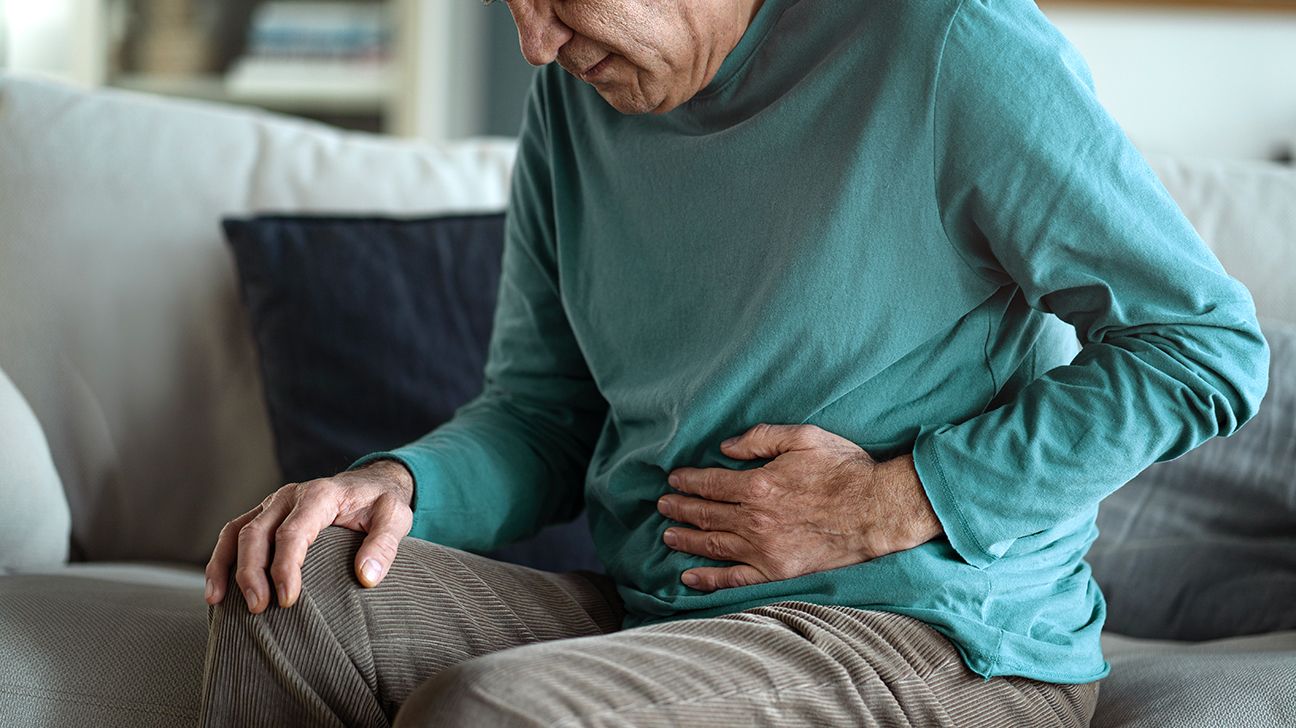While CLL can cause GI symptoms like abdominal pain, cramping, and diarrhea, it’s relatively rare. These types of symptoms are usually associated with more serious cases of the condition.

Chronic lymphocytic leukemia (CLL) makes up about
While it’s not very common, CLL can also cause stomach and abdominal symptoms. Here’s what to know if you have CLL and are experiencing stomach pain.
Pain and other gastrointestinal symptoms are
Possible stomach and abdominal symptoms in CLL include:
- dull pressure in your abdomen
- discomfort, swelling, or pain
- feeling full after eating even a small amount of food
- loss of appetite
- diarrhea or vomiting
- stomach cramping
CLL can cause abdominal pain and other symptoms when leukemia cells build up in and around your spleen, causing it to swell. In rare cases, CLL can also make the liver swollen and enlarged.
You might experience vague pain, back pain, or feelings of fullness. Sometimes, you may not have any symptoms at all, even if your spleen is swollen.
In rare cases, leukemia cells may cause inflammation and ulcers in your intestines. You may experience symptoms similar to those of inflammatory bowel disease (IBD) and low nutrition or malabsorption. These include:
- diarrhea
- nausea
- vomiting
- acid reflux
- stomach cramps or pain
- unintentional weight loss
- dark, bloody stools
Stomach pain and other CLL symptoms vary depending on what part of the body is affected by leukemia. Related abdominal and gastrointestinal issues include:
- Esophagitis: You may feel pain if your esophagus (food pipe) is affected by CLL. This may feel like painful swallowing, chest pain, or like food is stuck in the esophagus.
- Splenomegaly: When leukemia cells collect in the spleen, they can make it expand like a balloon. You may experience slight stomach pain, feelings of fullness, rib pain, or back pain. If part of your spleen is damaged, you may experience sharp pain on the left side of your abdomen.
- Neutropenic enterocolitis: If CLL affects the small or large intestines, it can lead to a condition called neutropenic enterocolitis. This can cause severe stomach pain and other symptoms such as fever, bloody diarrhea, vomiting, and stomach swelling. You may also experience pain in the lower right side of your abdomen.
- Lymphadenopathy: Leukemia cells can accumulate in lymph nodes, making them bigger. If this happens around the stomach area, it can lead to stomach pain.
Stomach pain and other abdominal symptoms in CLL usually occur in the later stages of the disease. These symptoms typically happen when a collection of leukemia cells puts pressure on or expands into your abdominal organs.
Some adults with CLL develop a serious condition called Richter’s syndrome. This can cause fast swelling of the lymph nodes, liver, and spleen. You may also have high levels of an enzyme called lactate dehydrogenase in your blood.
Speak with your doctor or a healthcare professional right away if you have CLL and begin to have stomach pain or any other new symptoms. They may recommend an ultrasound or CT scan of your abdomen to confirm whether CLL is causing your symptoms.
CLL-related stomach pain is usually treated by addressing underlying leukemia. Different treatment options are available to treat CLL, and you may have one or more
- Chemotherapy: This is a medication that slows the growth of cancer cells.
- Radiation therapy: These are high-energy X-rays that remove leukemia cells in the stomach, spleen, or other areas.
- Immunotherapy: These biologic drugs boost the body’s natural immunity to fight cancer.
- Peripheral blood stem cell and bone marrow transplant: This is a specialized therapy that removes leukemia cells and damaged stem cells in the bone marrow with high dose chemotherapy and then infuses healthy stem cells to build healthy bones, blood, and stem cells.
Your doctor may recommend supportive care for stomach pain and other related symptoms. These can include:
- pain relieving medication
- antidiarrheal drugs for persistent diarrhea
- over-the-counter antacid medications
- anti-nausea medications
- antibiotics for infections
- vaccinations to reduce the chance of infections, such as pneumonia and the flu
- antifungal medication in cases of fungal esophagitis
In some cases, stomach pain and other symptoms of CLL may be mild. Self-management strategies and a healthy lifestyle may help manage stomach symptoms.
For instance, try to eat a balanced diet with lots of colorful, whole foods and fruit and vegetables. These will also give you plenty of antioxidants for an immunity boost. If you have nausea or an upset stomach, try eating smaller meals more frequently, eat softer foods, and focus on foods that sit well with you.
CLL is one of the most common forms of leukemia in adults. Stomach pain and other abdominal symptoms are rare, but they can happen with CLL, especially in later stages.
In most cases, stomach pain and other symptoms will ease as your CLL is treated. Pain medications and home remedies can help soothe pain, nausea, and discomfort.
It’s important to keep your strength up by eating a balanced diet. Talk with your doctor or a nutritionist about the best way to get the nutrition you need.
